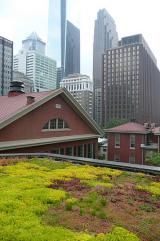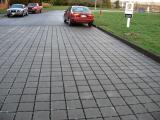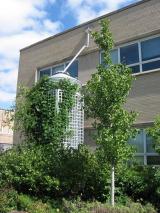Performance of Green Infrastructure
- reducing pollutant discharge to receiving waters,
- removing air pollutants, and
- reducing energy use.
Learn more on this page about how green infrastructure practices are working from EPA’s research and a sampling of studies, databases, and articles from environmental publications.
- Databases and Summary Reports
- Green Roofs
- Permeable Pavements
- Rainwater Harvesting
- Rain Gardens and Planter Boxes
- Bioswales
- Urban Tree Canopy
- Constructed Wetlands
- Watershed Scale
Databases and Summary Reports
Stormwater management objectives have shifted from controlling peak flows to mitigating impacts on water quality and ecosystems. Research on how well stormwater controls reduce pollutant concentrations and loads has generated vast quantities of data. Research organizations have developed databases and summary reports to help decision-makers interpret the data.
International Stormwater Best Management Practices (BMP) Database Exit—This database summarizes findings of more than 400 BMP studies. You can perform custom queries or download technical papers that summarize performance results. The database includes information on several green infrastructure controls.
National Pollutant Removal Performance Database, Version 3 (PDF)(10 pp, 1.2 MB, About PDF) Exit—This technical brief by the Center for Watershed Protection summarizes the results of the more than 150 performance studies that are included in the database. It includes statistical and graphical data on removal rates for several types of green infrastructure controls.
Runoff Reduction Method Technical Memo - Appendix F: BMP Research Summary Tables (PDF)(85 pp, 401 K, About PDF) Exit—This technical memo by the Center for Watershed Protection presents the results of more than 100 papers in tabular form. Water quality and quantity data are presented for green infrastructure and conventional controls.
Green Infrastructure for Stormwater Control: Gauging Its Effectiveness with Community Partners (PDF) (58 pp, 433 K, About PDF) —This report summarizes results to date from research conducted by the U.S. EPA's Office of Research and Development (ORD) into the performance of several green infrastructure practices. Scientists with ORD's National Exposure Research Laboratory/Water Supply and Water Resources Division worked with communities in eight EPA regions to evaluate impacts such as water quality changes, hydrologic response and soil infiltration.
- total nitrogen,
- total suspended solids,
- runoff volume, and
- peak flow.
- performance summaries for 17 stormwater treatment practices; and
- detailed cost and performance data for nine stormwater treatment practices.
Green Roofs
- reduce runoff volumes,
- regulate building temperatures,
- reduce urban heat island effects, and
- provide urban wildlife habitat.
- selection of plant species,
- propagation and establishment methods,
- plant succession,
- carbon sequestration potential, and
- water and nutrient requirements.
US EPA. 2009. Green Roofs for Stormwater Runoff Control (PDF)(50 pp, 4.5 K, About PDF). Publication No. EPA/600/R-09/026 | Abstract.
Oberndorfer, E., J. Lundholm, B. Bass, R. Coffman, H. Doshi, N. Dunnett, S. Gaffin, M. Kohler, K. Liu, and B. Rowe. 2007. Green roofs as urban ecosystems: Ecological structures, functions, and services Exit. BioScience 57(10):823–833.
Rowe, B. 2011. Green roofs as a means of pollution abatement Exit. Environmental Pollution 159(8–9):2100–2110.
Permeable Pavements
- infiltration and pollutant removal efficiency,
- long-term performance, and
- impacts on ground water quality.
- cooling surface temperatures,
- reducing runoff volumes, and
- improving water quality.
The study will provide the regulated community with much-needed design and performance data. The research site has already received awards, including EPA's Sustainable Champion Award and the Portland Cement Association Sustainability Leadership Award. See: Parking Lot Opening Ceremony Video Exit
US EPA. 2019. Cost Effective Tools for Assessment of Infiltration at Green Infrastructure Stormwater Management Sites. Publication No. EPA/600/F-19/141. U.S. Environmental Agency, Washington, DC.
US EPA. 2010. Surface Infiltration Rates of Permeable Surfaces: Six-Month Update (November 2009 through April 2010). Publication No. EPA/600/R-10/083. U.S. Environmental Protection Agency, Washington, DC.
Rowe, A., M. Borst, and T. O'Connor. 2010. Environmental Effects of Pervious Pavement as a Low Impact Development Installation in Urban Regions. Chapter 13 in The Effects of Urbanization on Groundwater: An Engineering Case-based Approach for Sustainable Development. N. Chang, ed. American Society of Civil Engineers, Reston, VA.
Adams, M. 2003. Porous asphalt pavement with recharge beds 20 years and still working Exit. Stormwater May–June.
Bean, E., W. Hunt, and D. Bidelspach. 2007. Evaluation of four permeable pavement sites in eastern North Carolina for runoff reduction and water quality impacts Exit. Journal of Irrigation and Drainage Engineering 133(6):583.
Bean, E., W. Hunt, and D. Bidelspach. 2007. Field survey of permeable pavement surface infiltration rates Exit. Journal of Irrigation and Drainage Engineering 133(3):249.
Boving, T., M. Stolt, J. Augenstern, and B. Brosnan 2008. Potential for localized groundwater contamination in a porous pavement parking lot setting in Rhode Island Exit. Environmental Geology 55(3):571–582.
Brattebo, B., and D. Booth. 2003. Long-term stormwater quantity and quality performance of permeable pavement systems Exit. Water Research 37(18):4369–4376.
Dreelin, E., L. Fowler, and C. Carroll. 2006. A test of porous pavement effectiveness on clay soils during natural storm events Exit. Water Research 40(4):799–805.
Rainwater Harvesting
- sizing methodologies,
- public perceptions, and
- the quality of harvested rainwater.
Craig, E., P. Coombes, et al. 2008. Rainwater tanks and microbial water quality: Are the indications clear? Exit Australian Journal of Water Resources 12(2).
Fletcher, T., A. Deletic, et al. 2008. Reuse of urban runoff in Australia: A review of recent advances and remaining challenges. Journal of Environmental Quality 37(5 Suppl):S116–127.
Jones, M.P., and W.F. Hunt. 2010. Performance of rainwater harvesting systems in the southeastern United States Exit. Resources, Conservation & Recycling 54:623–629.
Eroksuz., E., A. Rahman. 2010. Rainwater tanks in multi-unit buildings: A case study for three Australian cities Exit. Resources, Conservation, & Recycling 54(12):1449–1452.
Rain Gardens and Planter Boxes
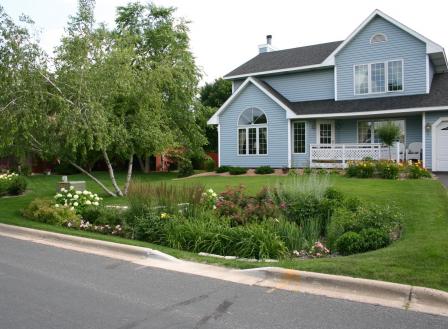 Rain gardens and planter boxes—both forms of bioretention—can support:
Rain gardens and planter boxes—both forms of bioretention—can support:- ground water recharge,
- pollutant removal, and
- runoff detention.
Bioretention also offers an effective approach to stormwater management where open space is limited. EPA is researching the performance and benefits of bioretention.
Davis, A. P., R. G. Traver, W. F. Hunt, R. A. Brown, R. Lee, and J. M. Olszewski. 2011. Hydrologic performance of bioretention stormwater control measures Exit. Journal of Hydrologic Engineering 17 (5), 604-614.
Li, H., and A. P. Davis. 2009. Water quality improvement through reductions of pollutant loads using bioretention Exit. Journal of Environmental Engineering 135(8):567–576.
Performance of Experimental Rain Gardens—This EPA research project, attached to EPA's experimental parking lot, is evaluating rain gardens as part of a larger treatment train. Video Exit
Muthukrishnan, S., and M. L. Oleske. 2008. Effects of lime amendment on the ph of engineered soil mix for the purposes of bioretention. Journal of Irrigation and Drainage Engineering 134(5):675–679.
O'Connor, T., A. Rowe, E. Stander, and M. Borst. 2010. Application of Time Domain Reflectometers in Urban Settings. Cities and the Environment 3(1):19.
Ray, A., A. Selvakumar, and A. N. Tafuri. 2006. Removal of selected pollutants from aqueous media by hardwood mulch. Journal of Hazardous Materials 132(2):89–96.
Shuster, W. D., R. Gehring, and J. Gerken. 2007. Prospects for enhanced groundwater recharge via infiltration of urban stormwater runoff: A case study. Mark Anderson-Wilk, ed. Journal of Soil and Water Conservation 62(3):129–137.
Stander, E., and M. Borst. 2008. Promoting nitrate removal in rain gardens. New Jersey Flows IX(II):5.
Stander, E. K., and M. Borst. 2010. Hydraulic test of a media carbon amendment. Journal of Hydrologic Engineering 15(6):531–536.
Stander, E., M. Borst, T. O'Connor, and A. Rowe. 2010. The Effects of Rain Garden Size on Hydrologic Performance. In Proceedings of the World Environmental & Water Resources Congress 2010: Challenges of Change, Environmental & Water Resources Institute of American Society of Civil Engineers, Providence, Rhode Island, May 16–20, 2010, pp. 3018-3027.
Bioswales
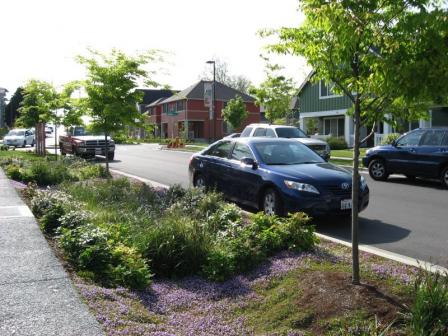 Bioswales—or vegetated swales—convey stormwater within a shallow channel. Research suggests that they can help in:
Bioswales—or vegetated swales—convey stormwater within a shallow channel. Research suggests that they can help in:- lessening peak flows,
- reducing pollutant loads, and
- enhancing biodiversity.
Performance of bioswales, however, is very sensitive to design.
Davis, A., J. Stagge, et al. (2012). Hydraulic performance of grass swales for managing highway runoff Exit. Water Research 46(20):6775–6786.
Kazemi, F., S. Beecham, and J. Gibbs. 2011. Streetscape biodiversity and the role of bioretention swales in an Australian urban environment Exit. Landscape and Urban Planning 101(2):139–148.
Xiao, Q., and E. McPherson. 2011. Performance of engineered soil and trees in a parking lot bioswales (PDF)(14 pp, 3 MB, About PDF) Exit. Urban Water Journal 8(4):241–253.
Urban Tree Canopy
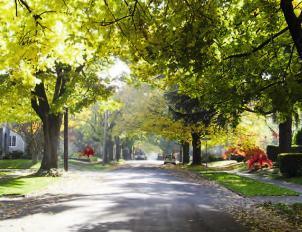 Trees in the urban environment can enhance habitat and property values while effectively:
Trees in the urban environment can enhance habitat and property values while effectively:- mitigating air pollution,
- reducing runoff quantity, and
- reducing energy use.
One area of active research is the interaction between urban trees and soils.
Bartens, J., S. Day, et al. 2008. Can urban tree roots improve infiltration through compacted subsoils for stormwater management? Journal of Environmental Quality 37:2048–2057.
Bartens, J., P. Wiseman, and E. Smiley. 2010. Stability of landscape trees in engineered and conventional urban soil mixes Exit. Urban Forestry & Urban Greening 9(4):333–338.
McPherson, G., J. Simpson, et al. 2005. Municipal forest benefits and costs in five US cities (PDF)(6 pp, 266 K, About PDF) Exit. Journal of Forestry 103(8).
Nowak, D., D. Crane, and J. Stevens. 2006. Air pollution removal by urban trees and shrubs in the United States Exit. Urban Forestry & Urban Greening 4(3–4):115–123.
Constructed Wetlands
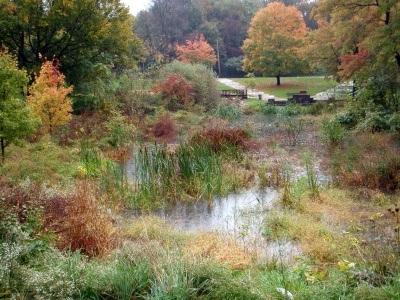 Constructed wetlands are complex systems with many design parameters. Scientists have examined wetland:
Constructed wetlands are complex systems with many design parameters. Scientists have examined wetland:- performance,
- design,
- management, and
- evaluation.
These resources discuss research by EPA and others on constructed wetlands.
O’Connor, T., and J. Rossi. 2009. Monitoring of a best management practice wetland before and after maintenance. Journal of Environmental Engineering 135(11):1145–1154.
Stander, E. K., and J. G. Ehrenfeld. 2009. Rapid assessment of urban wetlands: functional assessment model development and evaluation. Wetlands 29(1):261–276.
Stander, E. K., and J. G. Ehrenfeld. 2009. Rapid assessment of urban wetlands: Do hydrogeomorphic classification and reference criteria work? Environmental Management 43(4):725–742.
Arihood, L. D., E. R. Bayless, and W. C. Sidle. 2006. Hydrologic Characteristics of a Managed Wetland and a Natural Riverine Wetland along the Kankakee River in Northwestern Indiana (PDF)(88 pp, 1.1 MB, About PDF) Exit. Scientific Investigations Report 2006-5222. U.S. Geological Survey in cooperation with U.S. Environmental Protection Agency, Corvallis, OR.
US EPA. 2006. Performance of Stormwater Retention Ponds and Constructed Wetlands in Reducing Microbial Concentrations (PDF)(76 pp, 1.2 MB K, About PDF). Publication No. EPA/600/R-06/102 | Abstract.
Borst, M., A. L. Riscassi, L. Estime, and E. L. Fassman. 2002. Free-water depth as a management tool for constructed wetlands. D. L. Sutton, ed. Journal of Aquatic Plant Management 40:43–45.
Hunt, W. F., C. S. Apperson, S. G. Kennedy, B. A. Harrison, and W. G. Lord. 2006. Occurrence and relative abundance of mosquitoes in stormwater retention facilities in North Carolina, USA Exit. Water Science & Technology 52(6–7):315–321
Lenhart, H.A., and W.F. Hunt. 2011. Evaluating four stormwater performance metrics with a North Carolina coastal plain stormwater wetland Exit. Journal of Environmental Engineering 137(2):155–162.
Jones, M.P., and W.F. Hunt. 2010. Effect of Stormwater wetlands and wet ponds on runoff temperature in trout sensitive waters Exit. Journal of Irrigation and Drainage Engineering 136(9):656–661.
Watershed Scale
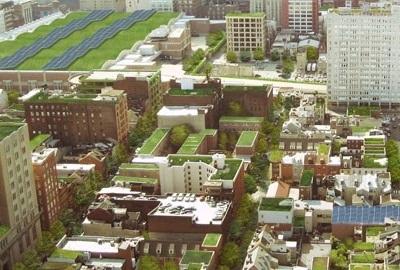 Green infrastructure is effective in protecting our water resources, including:
Green infrastructure is effective in protecting our water resources, including:- improving water quality; and
- maintaining stream form and function.
Researchers are working to link the performance of green infrastructure practices to water quality and ecological outcomes in receiving waters.
Dietz, M., and J. Clausen. 2008. Stormwater runoff and export changes with development in a traditional and low impact subdivision Exit. Journal of Environmental Management 87(4):560–566.
Hood, M., J. Clausen, and G. Warner. 2007. Comparison of stormwater lag times for low impact and traditional residential development Exit. Journal of the American Water Resources Association 43(4):1036–1046.
Nietch, C. T. 2008. Linking watershed management with stream ecosystem processes. EM: Air and Waste Management Associations Magazine for Environmental Managers January:37.
USGS. 2008. A Comparison of Runoff Quantity and Quality from Two Small Basins Undergoing Implementation of Conventional and Low-Impact-Development (LID) Strategies: Cross Plains, Wisconsin, Water Years 1999–2005 Exit. USGS Scientific Investigations Report 2008-5008. U.S. Geological Survey, Reston, VA.
USGS. 2010. Effects of Low-Impact-Development (LID) Practices on Streamflow, Runoff Quantity, and Runoff Quality in the Ipswich River Basin, Massachusetts: A Summary of Field and Modeling Studies. USGS Circular 1361 Exit. U.S. Geological Survey, Reston, VA.
Walsh, C. J., A. Roy, J. W. Feminella, P. D. Cottingham, P. M. Groffman, and R. P. Morgan. 2005. The Urban Stream Syndrome: Current knowledge and the search for a cure. Journal of the North American Benthological Society 24(3):706–723.


